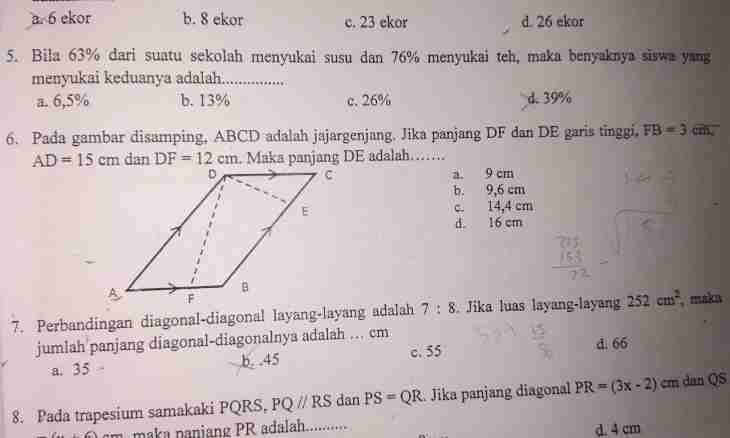Diagonal – the piece connecting two tops of any figure which are not lying on one party. For calculation of its length Pythagorean theorem or the theorem of cosines is most often used.
Instruction
1. diagonali/em/b"" class= "" colorbox imagefield imagefield-imagelink" of" rel= "" gallery-step-images""> Diagonal divides rectangular quadrangles (rectangle, a square) into two rectangular triangles, in each of which it will be a hypotenuse. Therefore, for its calculation the application of Pythagorean theorem is possible. a²=b²+c² where an is a hypotenuse, b and with - legs. Example 1: find AC diagonal if it is known that length of BC=3 cm, AB=5 cm. Decision: calculate AC hypotenuse in a rectangular triangle of ABC. AC²=AB²+BC²; AC²=5²+3²=34; take a square root from the received value: AC= √ 34=5.8 cm. Answer: diagonal of a rectangle is equal to 5.8 cm.
2. If before you a square, then it is possible to calculate diagonal, knowing one of its parties or the area. Since all parties of a square are equal, Pythagorean theorem for it will have an appearance: a²=b²+b², a²=2b². The area - the work of two parties (S=b²). Means, a hypotenuse square (in a figure a square) it is equal to its doubled area (a²=2S). Example 2: the area of a square is 16 cm². Find diagonal length. Decision: calculate length of diagonal and through the area. a²=2S, a²=2*16 cm²=32; take a root square: a= √ 32≈5,7 cm. Answer: square diagonal length – 5.7 cm.
3. In certain cases for calculation of diagonal it is necessary to do additional constructions. Example 3: an equilateral polygon with the party equal of 6 cm, a straight line BCD corner. Find length of diagonal AV.Reshenie: connect points of B and D. The rectangular triangle of BCD in which the party of BD is a hypotenuse turned out. Calculate BD hypotenuse: BD²=BC+CD²; BD²=6²+6²=72; BD Hypotenuse from a triangle of BCD is a leg in ABD triangle. And AB diagonal - a hypotenuse in it. Calculate AB diagonal: AB²=BD²+AD²=72+36=108; AB= √ 108=10.4 cm. Answer: AB=10.4 diagonal length see.
4. Diagonal of a cube can be found through the diagonal of one of its sides. Example 4: a cube with the party of 5 cm. Find cube diagonal. Decision: complete and calculate cube side diagonal. AC²=5²+5²=50. Diagonal of AC is perpendicular to CB edge, therefore, ACB corner – a straight line. AB cube diagonal – a hypotenuse in ACB triangle. Find cube diagonal length: AB²=AC²+CB²=50+25=75; take a square root. AB= √ 75=8.7 cm. Answer: cube diagonal length – 8.7 cm.
5. For calculation of diagonals of a parallelogram use the theorem of cosines: with²=a²+b a²-2ab*cosγ.Primer 5: a = 2 cm, b = 3 cm, γ = 120 °. Find page diagonal. Decision: substitute values in a formula. with² = 2²+3²-2*2*3*cos120 °; ° find cos120 according to the table of cosines (-0.5). with² = 4+9-12*(-0.5)=13-(-6)=19. Take a root from this value: with = √19 = 4.35 cm. Answer: diagonal length with = 4.35 cm.
